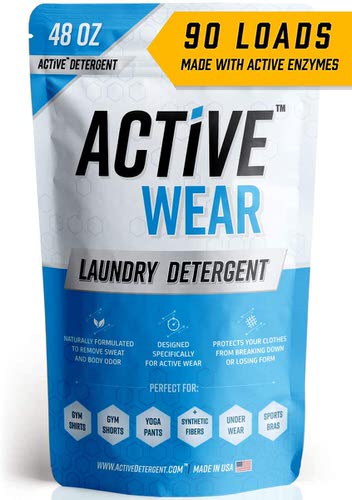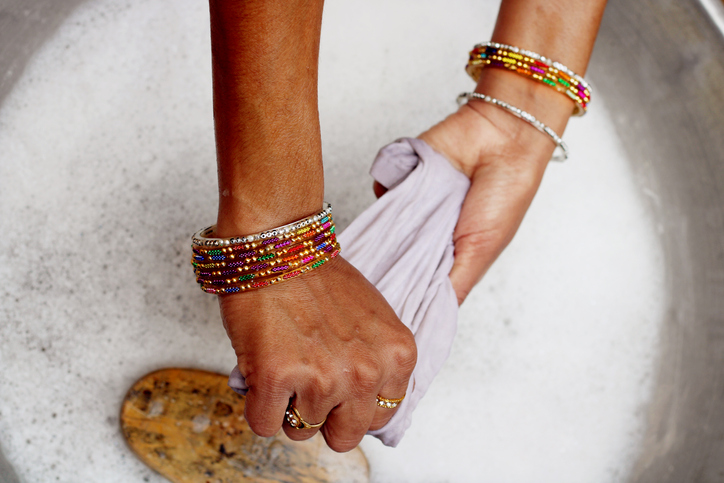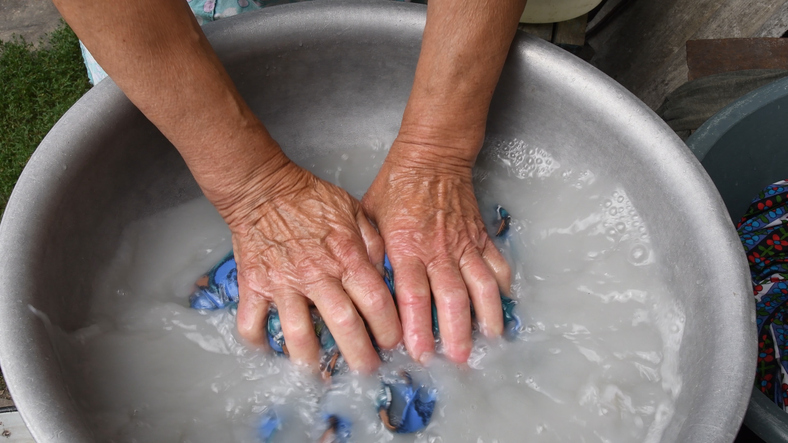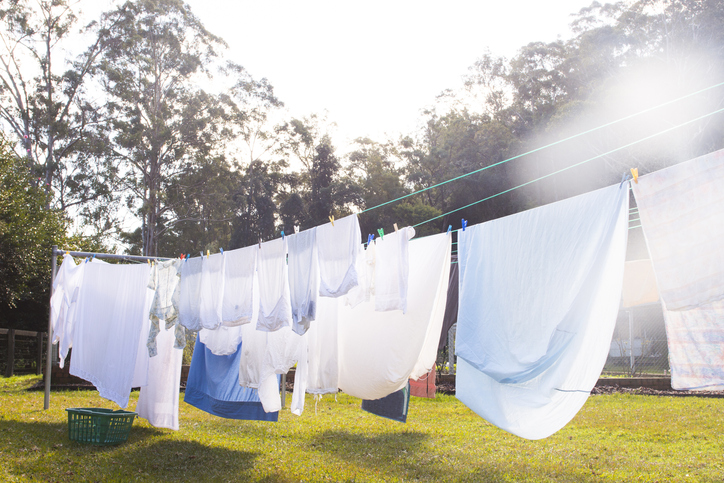photo by Glenn Pettersen via iStock
If you are an avid camper, trekker, or climber, you will often use a sleeping bag. So you already know it can get filthy and start to smell over time. You will need to clean it thoroughly, and because of its structure, it’s not always easy.
In this sleeping bag cleaning guide, we would like to share the methods you can use in order to clean dirt, sweat, and moisture residues off of your sleeping bag. In addition, we will also explain the drying methods because you have to dry the sleeping bag properly after cleaning.
Sleeping Bag Cleaning Guide: Washing Goose Down Sleeping Bags
Use only liquid detergent explicitly formulated when you are washing down products. Soap or detergents produced specifically for goose feathers will be the right choice for your sleeping bag. Avoid using regular detergent or soap; they are pretty complex and can damage the material.
When washing a down product, you should throw in a couple of tennis balls in the machine; they will separate the feathers through the cycle and let them get cleaned better. Also, follow the instructions for your product and the detergent you will use.
Sleeping Bag Cleaning Guide: Washing a Synthetic Filled Sleeping Bag
If your sleeping bag has synthetic fillings, use an unscented liquid detergent. Try to buy a special detergent for synthetic materials from local stores or online sites. You can also use a pinch of liquid fabric softener when washing the machine, as long as it is odorless.
Check the washing instructions to determine how much detergent to use on your sleeping bag. Never use powder detergent, powder softener, or bleach.
Sleeping Bag Cleaning Guide: What About the Washing Machine?
photo by M_a_y_a via iStock
You can machine wash your sleeping bag by applying the following items in the order, but some sleeping bags are not machine washable. Remember, if there is contrary information in the washing instructions of your sleeping bag, do not try to wash it in a machine.
Rinse Your Machine
photo by Andrii Shablovskyi via iStock
Before washing your sleeping bag in the machine, run the machine empty in the rinsing program. If your device does not have a rinsing program, try it with a prewash program. The prewash or rinse program removes detergent and softener residues. Thus, your sleeping bag will not be damaged.
You can also opt for running your washing machine on the shortest program with only water before you start washing.
Turn Your Sleeping Bag Inside Out
The next piece of advice in our sleeping bag cleaning guide is to turn the bag inside out. Doing so helps the sweat and body oils from the inside flow out easier. Close all zippers and zipper flaps before washing. Loosen all tension cords, and remove the foot attachment, if any.
If the outer layer of your sleeping bag is not waterproof, you don’t need to turn it inside out; you can wash it as it is.
Wash Your Sleeping Bag at Low Temperature
Choose a low-cycle program with low temperatures to wash your sleeping bag. The washing process should take about 35-40 minutes, depending on your machine. When the cycle is completed, rerun the rinsing program so you can get rid of soap and detergent residues left in your sleeping bag.
Sleeping Bag Cleaning Guide: Hand Washing Your Sleeping Bag
photo by pixelfusion3d via iStock
If the label of your sleeping bag says it is not suitable for washing in the washing machine or if you prefer a more delicate cleaning, hand washing is also an alternative. This method is ideal for you if you are worried about damaging your sleeping bag or if you do not have a delicate program with a pre-wash.
Wash Your Sleeping Bag in Cold Water
Our sleeping bag cleaning guide suggest to always use cold water to hand wash your sleeping bag. First, fill a tub with cold water. Next, add the appropriate detergent for the type of your sleeping bag to the cold water. Finally, use your hands to mix the detergent well with the water.
Be careful not to exceed the recommended amount of detergent on the label of your sleeping bag. Also, never use cheap detergents as they may damage your equipment.
Sleeping Bag Cleaning Guide: Pay Attention to the Material
If your sleeping bag has a waterproof lining, turn it inside out. Then, tightly close the zippers and zipper flaps. If your sleeping bag does not have a waterproof lining, place it in water as recommended in the washing instructions.
Soak Your Sleeping Bag in Water and Let the Detergent Spread
photo by Ninel Roshchina via iStock
After putting your sleeping bag in the water, press it down and soak it well with your hands. Then, try using your bare feet to completely submerge it in the water and keep moving it under the water with your hands or feet. This action will disperse the detergent better and clean the whole thing.
Sleeping Bag Cleaning Guide: Wash Between 30 Minutes to An Hour
After your sleeping bag is submerged in the tub and the detergent is thoroughly spread, leave the bag in the water for 30 minutes to an hour. Turn it upside down every 5 minutes and keep washing so every surface can get enough washing.
Don’t Forget to Rinse Your Sleeping Bag
After the washing process is finished, drain the tub with your sleeping bag in it. Then fill the tub again with cold water and soak it for an additional 5-10 minutes. Move the sleeping bag several times in the water to remove any detergent residue. Continue this process until you are sure that no detergent residue is left on your sleeping bag.
Sleeping Bag Cleaning Guide: Drying the Sleeping Bag
photo by manonallard via iStock
Since your sleeping bag is wet, it is essential to be sensitive when taking it out of the tub. Gently and slowly remove it from the tub and try to remove the entire sleeping bag at once so you can prevent it from being dragged.
Your sleeping bag will get heavy when it gets wet. Therefore, you may need to ask someone for help while removing it from the machine or the tub.
Drying with Dryer
Your sleeping bag will dry faster in the dryer. You can dry it in a front-loading dryer in a low-temperature setting. But you need to make sure the dryer is clean beforehand. Also, remember to check that no substance inside the machine will damage the sleeping bag.
Turn the dryer on its lowest setting; throw in a few absorbent towels and a couple of tennis balls with your sleeping bag. The towels allow the excess water to be absorbed, and the tennis balls prevent the sleeping bag from clumping.
Overheating the dryer will damage your sleeping bag so remember to stop the dryer periodically and open the door. Using this way, you can prevent it from overheating. You may need to repeat these steps several times for the sleeping bag to dry completely.
Sleeping Bag Cleaning Guide: Drying with the Classic Hanging Method
If you’re worried that the heat will damage your sleeping bag in the dryer, or if you don’t have access to a dryer, lay the bag outside on a flat table or hang it on a clothesline. Make sure the table or clothesline is in a place that gets the sun most of the day. You may need to wait around two days to dry the entire sleeping bag.
If the weather is bad outside and rain is expected for the next couple of days, dry them by spreading them inside your house.
Do Not Fold Immediately After Drying
After the drying process, it is beneficial to leave your sleeping bag outside for a couple more days instead of immediately folding or compressing them. This will make your sleeping bag smell cleaner, feel fluffier, and softer. Then, store your sleeping bags on a flat surface and simply zip up or pack them when you’re getting ready for a camping trip.
Sleeping Bag Cleaning Guide: Periodic Cleaning is a Must
You don’t need to follow these procedures every single time you use your sleeping bag. Instead, make a plan to clean your sleeping bag once or twice a year, perhaps before the first time you use it and again after the last time you use it for the season.
Unless…
You use it a lot. In that case, you might need one or two more washings over the course of the season.
Whatever the frequency you need to give your bag a thorough cleaning, this sleeping bag cleaning guide will be here to help!
Camping Gear You Need for Your Next Trip:
- Portable Power Station
- First Aid Kit
- Camping Cookset
- Camp Grill
- Camping Table
- Camp Chair
- Camping Lantern
- Waterproof Tarp
- Small Axe
- Solar Shower











